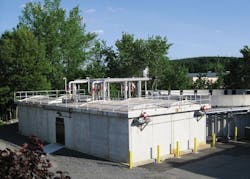About the author: Shannon Grant is president of ADI Systems Inc. Grant can be reached at [email protected] or 800.561.2831.
Food and beverage processing is resource-intensive. The industry requires large amounts of water, power and operator time in order to keep producing quality products. Compounding the problem is the public’s growing appetite for products made using sustainable methods—a concept that applies throughout all stages of the production process, including wastewater treatment.
Fortunately, companies are becoming more green-minded, recognizing that their processes must align with government-enforced environmental regulations. Many are going beyond the basic discharge requirements and investing in wastewater treatment technologies that make better use of resources. The right treatment technology not only allows food and beverage processors to stay environmentally compliant, it also can provide other benefits, including:
- Expanding plant operations: Increasing wastewater treatment capacity to easily allow for expansion as the business grows;
- Reducing or eliminating surcharges: Reducing costs associated with discharging untreated wastewater to a local municipal treatment plant by treating it on site;
- Lowering energy requirements: By modernizing plant operations with more efficient technology, plants can lower energy consumption and even produce energy, further reducing operational costs and dependency on external energy sources. Biogas captured from anaerobic digestion can be used in boilers to produce heat, burned in cogeneration engines to produce both electricity and heat, or, in some cases, sold back to the energy network for utility credits; and
- Providing reuse water: High-quality, polished effluent can be reclaimed for use in plant operations, improving overall water-use ratios.
Recovering valuable resources from wastewater has introduced the industry to a new way of thinking about wastewater: It does not need to be wasted. Instead of considering wastewater a problem, many food and beverage processors are re-evaluating their approaches to get more mileage from their treatment processes. Following is a sampling of food and beverage plants that have benefitted from new wastewater treatment approaches.
Ken’s Foods Reduces Operating Costs & Power Requirements
The Ken’s Foods plant in Marlborough, Mass., makes salad dressings, sauces and marinades. Its wastewater treatment system required an upgrade to treat additional flow and load, but lack of space made the upgrade tricky. An anaerobic membrane bioreactor, the ADI AnMBR, was selected because it combines anaerobic digestion and membrane filtration into one process, allowing it to be easily integrated into Ken’s Foods’ existing system.
Biogas produced from the treatment process is captured and used to scour membranes, heat the wastewater treatment system to mesophilic temperatures and provide the building with heat. The system not only has significantly improved effluent quality, it also has increased operating capacity by 60%, reduced operations and management costs by 50% and reduced sequencing batch reactor (SBR) power and aeration requirements by 85%.
Bellisio Foods Frees Up Operator Time
Bellisio Foods is a producer of frozen entrees. Due to rapid growth, the company’s main production facility in Jackson, Ohio, was having trouble keeping up with demands. The plant wanted a simple-to-operate waste-water treatment system that would generate minimal waste sludge.
Bellisio Foods selected an anaerobic wastewater treatment system, the ADI BVF reactor, which allows it to consistently meet all of the city of Jackson’s discharge limits. The system meets all of Bellisio’s treatment needs while offering simplicity and affordable operations and management costs. The entire operation is low maintenance and requires only four hours of monitoring by one plant operator per day.
HP Hood Expands Operations
HP Hood LLC is one of the largest dairy operators in the U.S. In order to keep pace with consumer demand, it has required multiple increases to production capacity at its plant in Winchester, Va., over the years. Its wastewater treatment process now consists of two anaerobic BVF reactors that operate in parallel, as well as SBR, influent and effluent equalization tanks, and a sludge holding tank.
The BVF reactors typically remove more than 95% of the chemical oxygen demand. The system converts organics into biogas, and provides HP Hood with more flexibility for handling and disposing of waste sludge. The upgrade has provided a 46% increase over the company’s previous average design flow, allowing it to successfully expand its operations while still meeting the publicly owned treatment works’ discharge limits.
Furmano Foods Recovers Green Energy From Wastewater
Furmano Foods’ production plant in Northumberland, Pa., processes millions of cases of tomatoes, beans, salads, vegetables and peppers each year. It was interested in recovering green energy from its wastewater, so it selected an anaerobic pretreatment system for digestion of organic wastes at its production facility.
The BVF reactor helps Furmano maximize biogas utilization from anaerobic digestion. Biogas is collected and fed into a 250-kW gen-set with gas drying and scrubbing capabilities. This generator converts biogas into electricity for the company’s onsite use and exports excess power to the grid. A heat recovery system on the gen-set is used to heat the reactor, saving the company money on heating costs.
As these case studies illustrate, food and beverage processors’ “pipe dreams” can, in fact, become reality. By enlisting wastewater treatment specialists to help meet increasingly strict environmental standards, many plants also are minimizing costs and better preparing themselves for future success.
Download: Here
